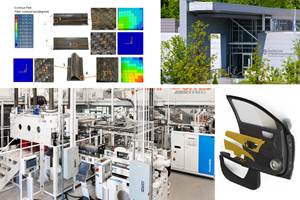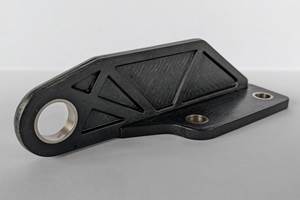University of Bristol, NCC develop novel composite materials to assess performance in space
In-house developed matrices reinforced with carbon fiber will spend six months attached to the ISS to better understand and improve their functionality in extreme space conditions.

International Space Station (ISS).
Composite materials developed by University of Bristol scientists and engineers with support from the National Composites Centre (Bristol, U.K.) will be blasted 250 miles from the Earth’s surface and affixed between two aluminum plates on the International Space Station (ISS), says a recent report issued by the university.
The novel composites will spend six months attached to the SESAME (Scientific Exploration Subsurface Access Mechanism for Europa) module of the ISS, orbiting the Earth some 3,000 times at speeds of 17,000 miles per hour. According to the university and the NCC, the materials are being placed on the ISS in order to test them in the fierce space environment, where they will be subjected to micro-meteoroids, temperatures from -150ºC to +150ºC, high-velocity dust, severe electromagnetic radiation and engineering debris. Real-time data will assess how the materials are performing and will reportedly help university scientists on the ground improve fiber-reinforced materials for next-generation space missions.
“This project will assess how our composites fare in the extreme space environment,” says Ian Hamerton, professor of Polymers and Composite Materials at the University of Bristol. Hamerton has been spearheading the Bristol said of the mission. “The data we recover will be used to make a ‘digital twin’ of the physical material, which will help us understand how these materials — and other materials — function. Not only will this improve the performance of our composites, but it will help us and others develop even more ambitious space materials.”
The matrix families for these composite materials have been developed in-house at the Bristol Composites Institute by two of the university’s PhD students, Dr. Yanjun (Desmond) He and Mayra Rivera Lopez. The first system includes three benzoxazine resins, based on blends of monomers obtained from Huntsman Advanced Materials (Basel, Switzerland) and modified to form nanocomposites. The benzoxazines, according to Hamerton, were developed in a PhD program with Oxford Space Systems (Harwell, U.K.) a company that specializes in deployable boom structures (i.e., ultra-thin CFRP laminates). The other system is said to be a novel cyanate ester resin system based on a monomer from Lonza AG (Visp, Switzerland), but chemically modified to enhance its reactivity and atomic oxygen (AO) erosion yield. HexForce PrimeTex 43098 S 1020 S carbon fiber was supplied by Hexcel Composites (Duxford, U.K.).
In support of the project, the NCC cured the composite samples and machined them to be tested prior to their launch to the ISS. More specifically, the specimens have been machined to have both thick (3-millimeter) and thin (0.3-millieter) sections, Hamerton says, which is designed to explore their utility in both deployable and structural applications. The samples are to be despatched to ESTEC (European Space Research and Technology Centre, Noordwijk, Netherlands) July 7 for preflight tests and integration into the module.
“The development and testing of our composites into real space conditions is a big step for us as researchers. Through this mission, we will assess the performance of our already resilient composites, but also, we will obtain a better perspective on ways to keep innovating the composites design,” says Lopez.
The space-bound materials are part of the Euro Ageing program, a £3.5 million European Space Agency (ESA) project which will see 45 materials exposed to the effects of space while encased in a chamber on the Bartolomeo platform — the ISS’ payload hosting platform — specially designed by Airbus (Toulouse, France). Places on the spring 2022 mission have been highly sought after and the university team are said to be faced with a five-month, highly competitive tender process to get their materials accepted.
“The composites we developed has already been proven to show an excellent performance in a simulated space environment, while this project is able to push it further by examine our composites in a real space environment, which help us gaining a deeper insight on the design of composites for space applications,” adds Dr. He.
It is said that the data will also be useful for CoSEM CDT (Centre for Doctoral Training in Composites Science, Engineering and Manufacturing) student George Worden, who expects to develop and use the ‘digital twin’ in his PhD program to break new ground in the field of space materials, including the potential to create composites with self-healing properties.
Financial support for the project has come from the UK Space Agency, the Science and Technology Facilities Council and the University of Bristol.
Related Content
Jeep all-composite roof receivers achieve steel performance at low mass
Ultrashort carbon fiber/PPA replaces steel on rooftop brackets to hold Jeep soft tops, hardtops.
Read MoreClemson Composites Center: Working with industry to transform composites
Offering liquid and thermoplastic composites molding, LCA-weighted simulation, full testing to validate materials/process data cards, CCC’s digital life cycle approach unites manufacturing, microstructure, part property map and structural analysis.
Read MoreOptimizing a thermoplastic composite helicopter door hinge
9T Labs used Additive Fusion Technology to iterate CFRTP designs, fully exploit continuous fiber printing and outperform stainless steel and black metal designs in failure load and weight.
Read MoreCFRTP enables better, greener smartphones
Carbon Mobile’s “monocoque” design eliminates separate case, cover and frame, better protects electronics and simplifies disassembly.
Read MoreRead Next
CW’s 2024 Top Shops survey offers new approach to benchmarking
Respondents that complete the survey by April 30, 2024, have the chance to be recognized as an honoree.
Read MoreComposites end markets: Energy (2024)
Composites are used widely in oil/gas, wind and other renewable energy applications. Despite market challenges, growth potential and innovation for composites continue.
Read MoreFrom the CW Archives: The tale of the thermoplastic cryotank
In 2006, guest columnist Bob Hartunian related the story of his efforts two decades prior, while at McDonnell Douglas, to develop a thermoplastic composite crytank for hydrogen storage. He learned a lot of lessons.
Read More


























